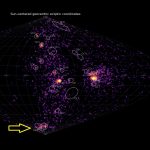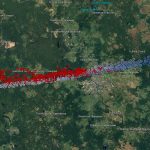Season’s Greetings again all,
Hope everyone is having a superb Christmas Day! I got yet another early Christmas gift this past Friday morning when the skies yet again somehow managed to clear out after midnight and I was able to get my best ever look at the obscure but quite intriguing Ursids (URS) from Matanzas Inlet (MI).
We used to joke about this shower in the early days of the ACAC as we had never seen much of anything in the way of activity from it, even though we tried. The jokes went something like: no matter how badly a meteor shower performed, at least it was bound to better than the Ursids.
We were still learning in those days, and it turns out we probably did not give the shower anywhere near its due. Also, we never tried observing it from MI either and we did not observe it at the right times. So, this year, armed with 40+ years of experience and a little help from Mother Nature, I was finally able to vindicate the shower a little bit, anyway.
I awoke at my usual 2:30 a.m. on Friday morning (without an alarm) and saw it was mostly clear. and MI was beckoning me. So, I arrived a bit before 3:30 a.m. and sure enough, the skies were stunning. The URS radiant is near the “bowl” of the Little Dipper in Ursa Minor and has the highest declination of all the meteor showers at +76 degrees (just 14 degrees from Polaris). This combined with the fact it occurs so close to Christmas makes it rarely observed at all. I call it the Winter Solstice Meteor Shower.
So, I faced a rare direction to view this shower: almost due north! The radiant was climbing up the NNE sky when I arrived and had barely reached an optimum elevation for viewing. Nonetheless, the shower didn’t take long to be apparent. All told, in 1.75 hours, I counted 19 URS, 6 late GEMs and 25 others for 49 total meteors in a very nice session indeed! Here’s my data:
Observed for radiants:
URS: Ursids
GEM: Geminids
ANT: Anthelions
MON: December Monocerotids
HYD: sigma Hydrids
DLM: December Leonis Minorids
DAD: December alpha Draconids
DSV: December sigma Virginids
Date: Dec., 21/22, 2017. Observer: Paul Jones, Location: north bank of Matanzas Inlet, Florida, 15 miles south of St. Augustine, Florida, Lat: 29.75 N, Long: 81.24W, LM: 6.5, sky conditions: 10 – 25% clouds, Facing: NNE.
0330 – 0430 EST (0830 – 0930 UT), Teff: 1 hour, clear, no breaks
10 URS: +1(1), +2(2), +3(3), +4(3), +5(1)
3 GEM: +2(1), +3(2)
1 DSV: +2(1)
1 HYD: +3(1)
1 DLM: +3(1)
11 SPO: -2(1), -1(1), +2(2), +3(2), +4(3), +5(2)
27 total meteors
3 URS and 3 SPO left visible trains, most common colors were gold and yellow in the brighter SPOs.
0430 – 0515 EST (0830 – 0915 UT), Teff: .75 hour, 25% clouds no breaks
9 URS: +1(1), +2(3), +3(3), +4(2)
3 GEM: +2(2), +3(1)
1 HYD: +3(1)
9 SPO: +1(2), +2(1) +3(2), +4(2), +5(2)
22 total meteors
2 URS and 2 SPO left visible trains, most common colors were blue and yellow in the brighter SPOs.
Nineteen URS in almost two hours does not seem like a lot, but compared to what we used to see from them, this was a windfall… ;o). Some pesky cumulus clouds came in on me off the Atlantic which may have cut into the meteors somewhat. I will surely be on the lookout for them in coming years.
Wishing everyone a happy and prosperous new year and see you on January 1st for our regular monthly meeting,. Paul






